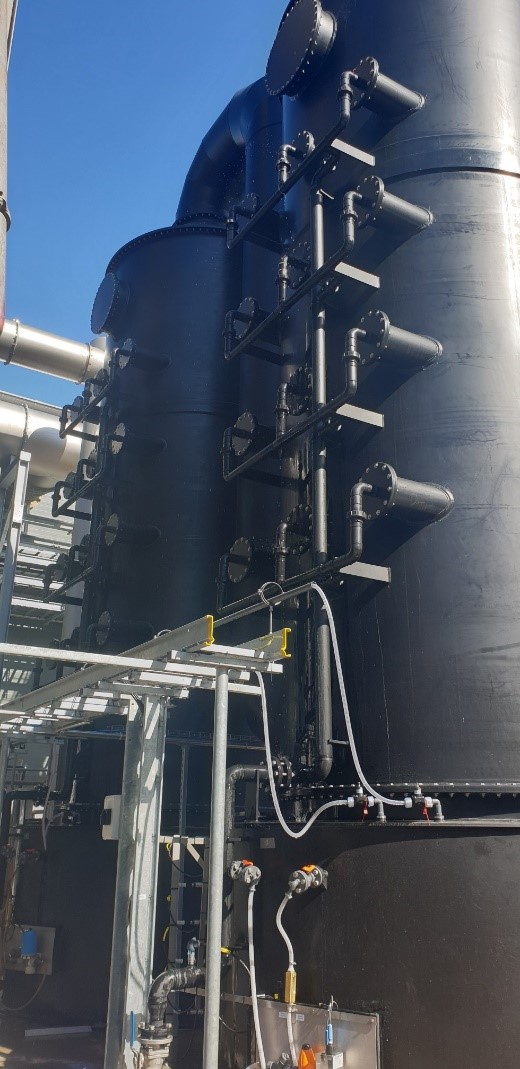Syngas
 Gasification is a well-known technology and new applications are fueled as a replacement for fossil fuels with renewable energy sources to reduce CO2 emissions. Syngas generated by gasification contains impurities which will impede direct use. Impurities can cause severe problems to operating facilities. Corrosion, fouling, clogging of instrumentation, damage and tarring of machinery are serious problems that can lead to accidents and downtime. Main pollutions in the syngas to be eliminated with a scrubber can be classified as:
Gasification is a well-known technology and new applications are fueled as a replacement for fossil fuels with renewable energy sources to reduce CO2 emissions. Syngas generated by gasification contains impurities which will impede direct use. Impurities can cause severe problems to operating facilities. Corrosion, fouling, clogging of instrumentation, damage and tarring of machinery are serious problems that can lead to accidents and downtime. Main pollutions in the syngas to be eliminated with a scrubber can be classified as:
- Fine dust (solid particulate matter)
- Alkali compounds
- Nitrogen compounds
- Tar
- Light hydrocarbons (methane, ethane)
- Heavy hydrocarbons
Depending on the kind of biomass used other components could originate or being released.
Different methods
There are several methods to improve the syngas to comply the necessary requirements. This article deals with wet gas scrubbing technology which decrease the amount of impurities in the syngas to use it for instance in combustion engines or methanization systems. The syngas is contaminated and has a high discharge temperature (< 800°C).
Operators of gasification systems focus regularly on tar elimination, polycyclic aromatic hydrocarbons (PAHs) reduction and fine dust particulate removal (ash and soot). The objective of Ravebo is to investigate tar elimination, which is a mixture of heavier hydrocarbons and compounds. Water and an organic liquid (solvent) predominantly have to be applied for tar and PAHs elimination from syngas.
Nowadays rapeseed methyl ester and biodiesel appear to be more environmentally friendly, are the most common organic liquids, sometimes used in combination with alcohols.
Principle gas scrubbers
Open spray systems operate based on the difference in velocity potential between liquid droplets and the incoming gas. The liquid is pumped with moderate pressure through nozzles with the objective to get a homogeneous droplet distribution and equal spray pattern. The droplet size is especially important since ultrafine droplets have a particularly large surface to volume ratio. In vertical countercurrent absorbers the droplets fall under the influence of gravity through the upwards rising gas stream and make intense contact with the contaminant particles in the gas. The exceptionally fine droplets create all together a fine mist with which results in an efficient capture of particles. The spray absorbers operate relatively simply and are very maintenance-friendly with fairly low energy costs.
Due to the lack of random packing or a structural packing, open spray absorbers have an exceedingly small pressure loss and are virtually insensitive to contamination, which normally cause a larger pressure difference. The scrubber works according to a closed-loop pump system in which the washing liquid is pumped from the buffer. Based on measurement values fresh water can then be added automatically and then drained on basis of other measured principles.
The positioning of the spray nozzles in the scrubber is of the utmost importance for optimal gas treatment, by capturing particles because of intensive contact between washing fluid and the syngas. The clogging-free nozzles create ultrafine droplets with a homogeneous spray pattern to capture practically all dust particulate and absorb gas particles.
Characteristics open-spray scrubbers
- The counter current scrubber consists of a horizontal, rectangular housing or a vertical column which, seen in the flow direction, is made up of multiple series-placed washing sections in which spraying is done with a combination of a quench, a chemical section, a neutral section, and non-polar solvent sections.
- Each washing section is equipped with multiple spray arms in a row or above each other on which essentially clogging-free nozzles are mounted to obtain a long spraying path. The spray arms are mounted in such a way that the nozzles rinse the inside of the washing section well at the same time.
- The positioning of the spray nozzles in the scrubber is of the utmost importance for optimal gas cleaning for capturing particles through intensive absorption of the particles in the process gas. Optimal contact of fine liquid droplets with gas and dust particles will lead to a large uptake of polluting components.
- Each washing section is equipped with an inspection hatch so that the rectifiers, spraying nozzles, and droplet separators can be checked, cleaned, or even replaced very easily.
